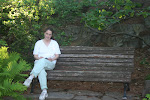With the overcast sky threatening an imminent downpour, we decided to head over to the exhibition garden, where if necessary we could find shelter in one several large pergolas.
Of particular interest in the exhibition garden is Lea Vivot’s controversial bronze entitled “The Lover's Bench.” I remember the sculpture when it was on Sherbrooke Street near McGill University. I prefer it here in the garden tucked away under the trees at the head of the small pool and fountain. Here is a playful photo of Jack posing with the three lovers depicted in the sculpture.
I met Jack when he first came to Montreal. He was living at the time in my own neighbourhood of Verdun. Jack is a real organizer and established a memorable poetry reading series at a former Verdun cafe called “Van Gogh’s Ear.” He has since founded The Foundation for Public Poetry and last September organized the highly successful Montreal Public Poetry Festival. This year he is putting together a collection of poems in honour of Leonard Cohen’s 75th birthday. Jack is hoping to raise money through book sales and a Gala to finance a Writer-in-Residence Programme at Westmount High, Cohen’s former school.
But today we were both concentrating on the garden, which after so much rain this summer was lush and green. We each picked a spot—fortunately the rain held off—and settled down to write. At the end of our writing session, Jack presented me with the following villanelle composed on the spot.
But today we were both concentrating on the garden, which after so much rain this summer was lush and green. We each picked a spot—fortunately the rain held off—and settled down to write. At the end of our writing session, Jack presented me with the following villanelle composed on the spot.

As a poetry form, the villanelle has been around for at least three hundred years. With its frequent refrains and complex rhyming, it has its origins in native songs. The name itself derives from the Italian villa, or country house, where noblemen went to relax and get closer to nature, making this a form of poetry ideally suited to writing about a garden.
Here is Jack’s poem—probably the first ever villanelle inspired by the Montreal Botanical Garden.
Pondering My Future At Jardin Botanique
For K.E.S.
Pondering my future at Jardin Botanique
The rain impacts in a craterous way
Surrounded by flowers, yet, only one I seek.
The grey above cannot bring about bleak
Nor can my departure from earning pay
Pondering my future at Jardin Botanique
I see her eyes reflect from stones in creek
I see her eyes in every lily day
Surrounded by flowers, yet, only one I seek.
When peace of parks and poetry become chic
The message of birds we'll learn to obey
Pondering my future at Jardin Botanique
As proud leaves drop I hear them speak
Returning to you pushes my pain away
Surrounded by flowers, yet, only one I seek.
I sense your scent when I press cheek to cheek
I sense you worry when I'm away
Pondering my future at Jardin Botanique
Surrounded by flowers, yet, only one I seek.
Pondering My Future At Jardin Botanique
For K.E.S.
Pondering my future at Jardin Botanique
The rain impacts in a craterous way
Surrounded by flowers, yet, only one I seek.
The grey above cannot bring about bleak
Nor can my departure from earning pay
Pondering my future at Jardin Botanique
I see her eyes reflect from stones in creek
I see her eyes in every lily day
Surrounded by flowers, yet, only one I seek.
When peace of parks and poetry become chic
The message of birds we'll learn to obey
Pondering my future at Jardin Botanique
As proud leaves drop I hear them speak
Returning to you pushes my pain away
Surrounded by flowers, yet, only one I seek.
I sense your scent when I press cheek to cheek
I sense you worry when I'm away
Pondering my future at Jardin Botanique
Surrounded by flowers, yet, only one I seek.
J.J. Locke

While Jack worked on his villanelle, I wrote a few tanka in one of the pergolas. If tanka can be considered "a quick check on the state of the heart," then here's what I'm thinking about at the moment.
in the garden
at the height of summer
if I could choose
only one
which flower would I pick?
*
Adam alone
in paradise
rain on the climbing vines
even before
he dreamt of Eve
Adam alone
in paradise
rain on the climbing vines
even before
he dreamt of Eve
*
told
I lack subtlety
still
there’s nothing shy
about this crimson begonia
I lack subtlety
still
there’s nothing shy
about this crimson begonia





































